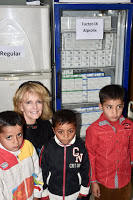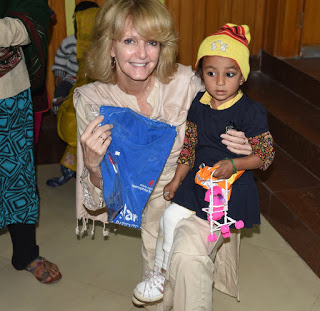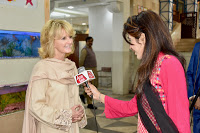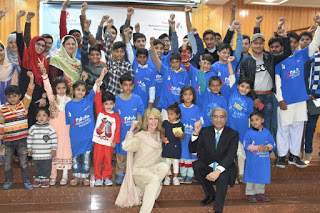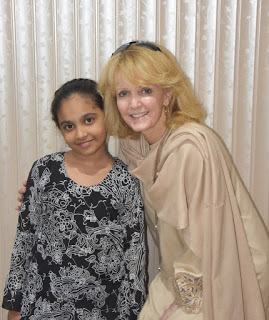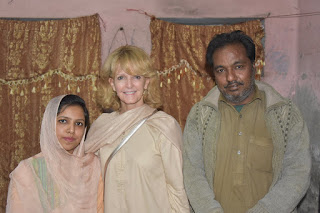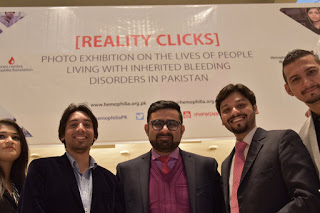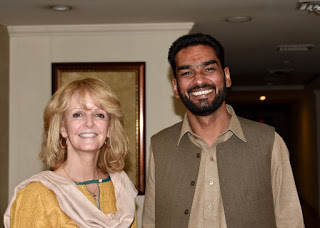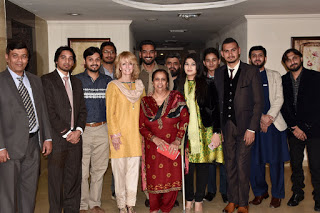1,445
At the airport, Masood Fareed Malik and his wife Sehar
were waiting outside in the cool, dry air. I first met Masood, now 35, when he was 17! It
was great to be here again. I love Lahore, a wide city, more lush and dry than
Karachi, with a high population of 11 million. I first visited in 1999, when
the Pakistan Hemophilia Patient Welfare Society (PHPWS) was only two years old,
and the Lahore chapter was in its infancy.
were waiting outside in the cool, dry air. I first met Masood, now 35, when he was 17! It
was great to be here again. I love Lahore, a wide city, more lush and dry than
Karachi, with a high population of 11 million. I first visited in 1999, when
the Pakistan Hemophilia Patient Welfare Society (PHPWS) was only two years old,
and the Lahore chapter was in its infancy.
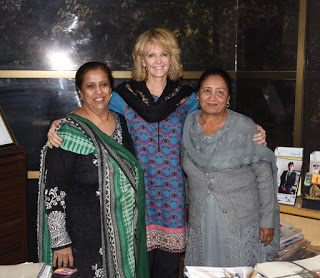 |
| Laurie Kelley with Dr. Shahla (L) and Sister Margaret |
On Friday, December 1 we went to the chapter office, which is
jam-packed with shelves, resources, refrigerators and people. One room is an administration room, the other is the factor/infusion
room, which completely impressed me. It has a security camera mounted on the
wall. The seven fridges are broken down by purpose of the donation, including “NMO”
only (national member organization of the WFH, so this means donations from the
WFH and most likely, Eloctate and Alprolix); “prophy” (also from the Bioverativ
donation); “Other” (VWF and bypassing agents). Their on-line registry is better
than anything I’ve ever seen! This chapter is a model of management, efficiency
and transparency. And when I visited in 1999, the first thing I asked was what
their goals were. They had none, and no vision, no registry, nothing! Now—supermodel for the world.
jam-packed with shelves, resources, refrigerators and people. One room is an administration room, the other is the factor/infusion
room, which completely impressed me. It has a security camera mounted on the
wall. The seven fridges are broken down by purpose of the donation, including “NMO”
only (national member organization of the WFH, so this means donations from the
WFH and most likely, Eloctate and Alprolix); “prophy” (also from the Bioverativ
donation); “Other” (VWF and bypassing agents). Their on-line registry is better
than anything I’ve ever seen! This chapter is a model of management, efficiency
and transparency. And when I visited in 1999, the first thing I asked was what
their goals were. They had none, and no vision, no registry, nothing! Now—supermodel for the world.
Several patients were there to
get infusions; they are not charged money but are encouraged to donate
something to the chapter. They have over 650 registered patients, and their
leadership is outstanding. These young men—Faizan, Adil, Masood, Rauf,
Farooq—are exceptional! Adil was the young teen I visited back in 2007 at his
home; Patrick Schmidt, CEO of FFF Enterprises bought him a computer at my
request, and now he does data entry for the chapter among other things, is over
6 ft. tall, married with a baby!
get infusions; they are not charged money but are encouraged to donate
something to the chapter. They have over 650 registered patients, and their
leadership is outstanding. These young men—Faizan, Adil, Masood, Rauf,
Farooq—are exceptional! Adil was the young teen I visited back in 2007 at his
home; Patrick Schmidt, CEO of FFF Enterprises bought him a computer at my
request, and now he does data entry for the chapter among other things, is over
6 ft. tall, married with a baby!
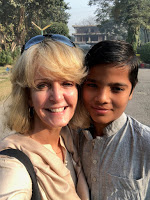 |
| Kashi with his first gori |
Saturday December 2, 2017was a huge community event at the Children’s
Library in Lahore, sponsored by a grant from the Novo Nordisk Haemophilia
Foundation. As I got into the car, Masood pointed out Kashi, a young boy with a
sly smile, who was helping him. Masood told me that Kashi has never seen a
“gori” before—a white person. So, I acted a bit silly with him, got him smiling
and we took a selfie!
Library in Lahore, sponsored by a grant from the Novo Nordisk Haemophilia
Foundation. As I got into the car, Masood pointed out Kashi, a young boy with a
sly smile, who was helping him. Masood told me that Kashi has never seen a
“gori” before—a white person. So, I acted a bit silly with him, got him smiling
and we took a selfie!
Many patients were already there
waiting. I like to make it a point to greet the audience, to break the ice, so
I walked about, shaking hands, smiling, saying assalam-u-alaikum to all the families. I noted that in general men
sat on the left, women on the right.
waiting. I like to make it a point to greet the audience, to break the ice, so
I walked about, shaking hands, smiling, saying assalam-u-alaikum to all the families. I noted that in general men
sat on the left, women on the right.
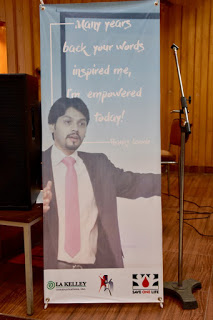 The ceremony took most of the day. There
The ceremony took most of the day. Therewere speeches, awards, and I gave my talk and shared the successes of Save One
Life. I handed out the Save One Life distribution funds for all the
beneficiaries. Much of the day was a photo op. The press was present, and we
had four back-to-back interviews for TV. Many of the young men, even the
reporters, wanted selfies! One nice touch was the stand Masood made in my honor,
with his photo: “Many years back your words inspired me. I am empowered today!
Thanks, Laurie” That was sweet! Masood has become quite the national leader for
hemophilia in Pakistan.
Some takeaways: Masood said, “You [with hemophilia] think you have been cursed but you have been blessed. Because
you are special. God only gives burdens to those he thinks are special, worthy,
strong. This is from the Koran.” One fact of note is that there is a high incidence of
rare factor deficiencies due to family intermarriages. It is quite common for
first cousins to marry.
you are special. God only gives burdens to those he thinks are special, worthy,
strong. This is from the Koran.” One fact of note is that there is a high incidence of
rare factor deficiencies due to family intermarriages. It is quite common for
first cousins to marry.
Finally, after this long day, we still
decided to visit families in their homes!
decided to visit families in their homes!
First, we drove to the house of ten-year-old
Momina, who has VWD type 3, and who wants to be a doctor. We discovered on this
trip that has a baby brother Alyan who also has VWD—he’s not registered with
Save One Life so we will get him registered now. They live in a concrete home,
with extended family, very typical in Pakistan. They live on the base floor,
and have a tiny kitchen with a cloth covering the door, 1 bedroom for everyone,
a motorbike in the hallway. They have a small flat screen TV and fan, all in
the sitting room, which was very small. The father earns 1,500 rupees a month ($150)
and spends 1,200 on school. School is a necessity for kids with bleeding
disorders but public schools can be dangerous: there are bullies, and some teachers
cane the children.
Momina, who has VWD type 3, and who wants to be a doctor. We discovered on this
trip that has a baby brother Alyan who also has VWD—he’s not registered with
Save One Life so we will get him registered now. They live in a concrete home,
with extended family, very typical in Pakistan. They live on the base floor,
and have a tiny kitchen with a cloth covering the door, 1 bedroom for everyone,
a motorbike in the hallway. They have a small flat screen TV and fan, all in
the sitting room, which was very small. The father earns 1,500 rupees a month ($150)
and spends 1,200 on school. School is a necessity for kids with bleeding
disorders but public schools can be dangerous: there are bullies, and some teachers
cane the children.
Outside, in the enveloping dark, neighborhood
children played in the dirt with toy camels and donkeys and colored chalk,
celebrating the life of the prophet Mohammad. Yesterday was his birthday.
children played in the dirt with toy camels and donkeys and colored chalk,
celebrating the life of the prophet Mohammad. Yesterday was his birthday.
On we drove to visit Saida, who
we saw at the ceremony today. A pretty 19-year-old girl with VWD type 3, petite
and quiet. She is on the Womens Group committee. Her father is a car mechanic, but lost his job (Masood didn’t know
that and was genuinely surprised and concerned). She’s waiting to be accepted
to nursing school. And she tutors about 20 kids after school to make ends meet.
They live in a family home, which is rundown, with plaster chipped off the wall. I gave her father $200 to help them out while he is out of a job.
we saw at the ceremony today. A pretty 19-year-old girl with VWD type 3, petite
and quiet. She is on the Womens Group committee. Her father is a car mechanic, but lost his job (Masood didn’t know
that and was genuinely surprised and concerned). She’s waiting to be accepted
to nursing school. And she tutors about 20 kids after school to make ends meet.
They live in a family home, which is rundown, with plaster chipped off the wall. I gave her father $200 to help them out while he is out of a job.
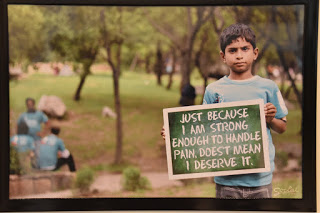 In the afternoon of Monday December 4, 2017, we attended an Art
In the afternoon of Monday December 4, 2017, we attended an ArtGallery presentation of photos of hemophilia, in an art show called “Reality
Clicks,” a project again sponsored by the Novo Nordisk Haemophilia Foundation. The photographer was none
other than Masood’s brother Bilal. The photos, displayed around the entire
circular room, showed patients in various situations: in pain, with one
another, at work. The press arrived in force again, and interviewed Bilel,
Masood, and Dr. Shahla. The entire project helps to promote hemophilia
awareness nationally.
I’ll never forget what one young
man with hemophilia, Haroun, said: “I felt God never blessed me. I compared
myself to normal people. I had anxiety attacks. But then I joined the PHPWS. I
experienced my own community at last and found that I was actually better off than many of the patients. So
I was wrong to compare myself to normal people.”
man with hemophilia, Haroun, said: “I felt God never blessed me. I compared
myself to normal people. I had anxiety attacks. But then I joined the PHPWS. I
experienced my own community at last and found that I was actually better off than many of the patients. So
I was wrong to compare myself to normal people.”
We had a lovely time, and
afterwards, went to Masood’s father’s house, where they all live, to have “high
tea.” A snack to them, which to me is as grand a meal as I have ever had!
afterwards, went to Masood’s father’s house, where they all live, to have “high
tea.” A snack to them, which to me is as grand a meal as I have ever had!
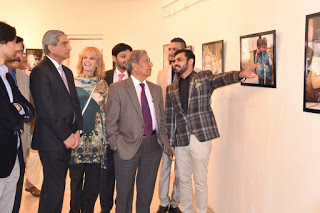 On Tuesday December 5, 2017 I attended all day the Annual
On Tuesday December 5, 2017 I attended all day the AnnualGeneral Meeting of the national hemophilia organization at the Shalimar Hotel. Saeed
ul Hassangave an excellent presentation
on the patient registry, and mapped out where patients were. He said their
registry was recognized as a success story by the WFH, and I can clearly see why.
Now in 2017 they have 1,850 registered. They use this registry for organization
elections, like an electoral college. 1 vote per 50 patients. With the registry
they found that 40.7% of their patients have joint deformities and 92.6% were not
tested for HIV.
Pakistan has four provinces: Khyber Pakhtunkhwa
Province (KPK), Punjab, Sindh and Baluchistan. The tribal belt adjoining KPK is
managed by the Federal Government and is named FATA i.e., Federally
Administered Tribal Areas. What was truly awesome was that at this meeting, I
met patients from FATA, a place that has me intrigued.
Province (KPK), Punjab, Sindh and Baluchistan. The tribal belt adjoining KPK is
managed by the Federal Government and is named FATA i.e., Federally
Administered Tribal Areas. What was truly awesome was that at this meeting, I
met patients from FATA, a place that has me intrigued.
Syed Shabistan
is a teacher, tall, with incredibly straight white teeth, impeccable English
and from Peshawar. Peshawar is the capital of KPK, and serves as the
administrative center and economic hub for FATA. Peshawar’s recorded history dates back to 539 BC, making it one of the oldest cities in Pakistan. Its economy has benefited in times past from being at the entrance to the Khyber Pass, the ancient travel route for trade between Central Asia and the Indian Subcontinent. Think of all the tea and spices that traversed this!
is a teacher, tall, with incredibly straight white teeth, impeccable English
and from Peshawar. Peshawar is the capital of KPK, and serves as the
administrative center and economic hub for FATA. Peshawar’s recorded history dates back to 539 BC, making it one of the oldest cities in Pakistan. Its economy has benefited in times past from being at the entrance to the Khyber Pass, the ancient travel route for trade between Central Asia and the Indian Subcontinent. Think of all the tea and spices that traversed this!
Syed was only diagnosed
at age 23. There they speak Pashto. With him was Tahir Oman, the VP, and person
with hemophilia, and Faheem, who also has hemophilia. On June 2013 Peshawar
became operational as a chapter and already they identified 335 patients. How
different this area is from Karachi and Lahore: its has been negatively impacted from the rise
in global violence and is economically depressed. Syed told me there is a
great need for help from programs like Save One Life.
at age 23. There they speak Pashto. With him was Tahir Oman, the VP, and person
with hemophilia, and Faheem, who also has hemophilia. On June 2013 Peshawar
became operational as a chapter and already they identified 335 patients. How
different this area is from Karachi and Lahore: its has been negatively impacted from the rise
in global violence and is economically depressed. Syed told me there is a
great need for help from programs like Save One Life.
This meeting showcased Pakistan’s excellent progress in hemophilia. The country
still needs to identify the remaining 17,000 or so people with hemophilia, but
is on its way to do so. Pakistan has among the best doctors in the world, and
while lacking some resources, is making headway. Donations of factor will not
last forever, but it gives everyone motivation and has allowed patients to be
on prophy for the first time in history! Thanks to Bioverativ and WFH.
still needs to identify the remaining 17,000 or so people with hemophilia, but
is on its way to do so. Pakistan has among the best doctors in the world, and
while lacking some resources, is making headway. Donations of factor will not
last forever, but it gives everyone motivation and has allowed patients to be
on prophy for the first time in history! Thanks to Bioverativ and WFH.
Best, of
all, Save One Life is being implemented perfectly in the country, with all
three program partners. My happiest moment, besides meeting our beneficiaries
in their homes, was knowing that we can focus next year on Peshawar, knowing we
have these three skilled men with hemophilia to help us.
all, Save One Life is being implemented perfectly in the country, with all
three program partners. My happiest moment, besides meeting our beneficiaries
in their homes, was knowing that we can focus next year on Peshawar, knowing we
have these three skilled men with hemophilia to help us.
We made
plans for me to visit Peshawar next year, inshallah!
plans for me to visit Peshawar next year, inshallah!

